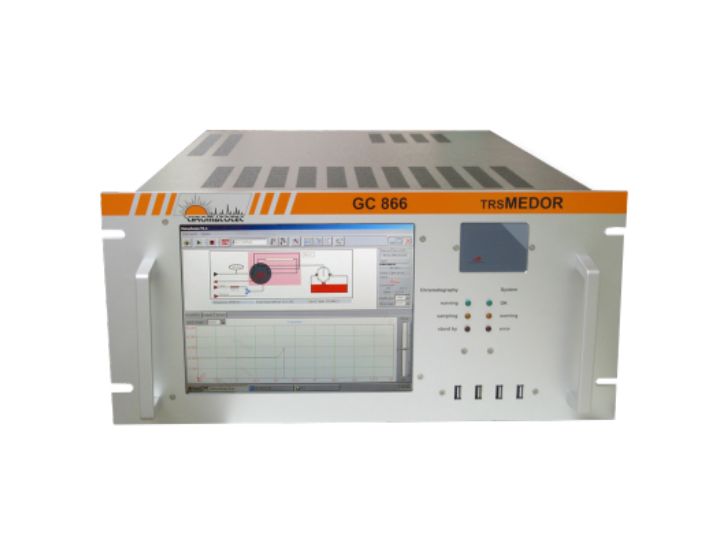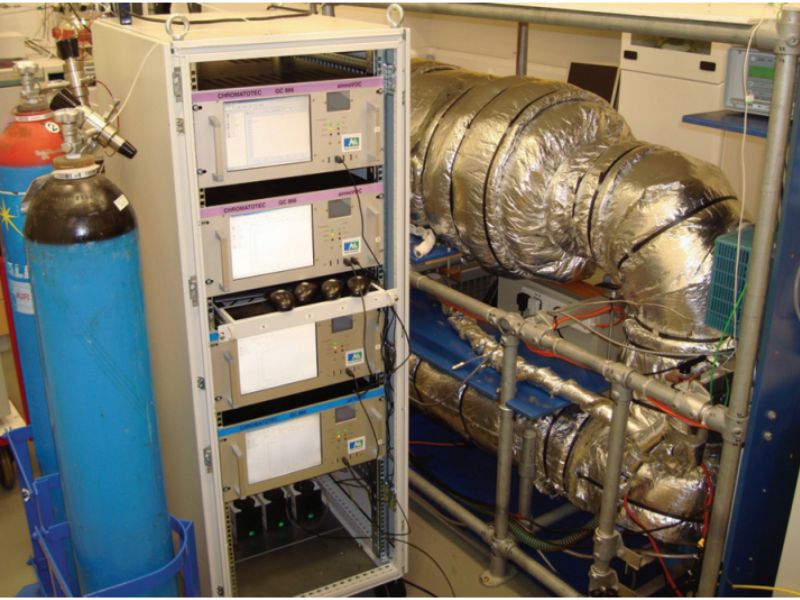Increasingly growing industries require modern, fast and automatic analytical equipment and systems. To meet that need, the manufacturer Chromatotec has researched and developed automatic chromatography (autoGC) systems that continuously help improve the efficiency and process of gas analysis in industry, providing continuous data and Accurate composition of air pollutants.
Product

TRS MEDOR
- Model: TRS MEDOR
- Manufacturer: Chromatotec
- The TRSMEDOR® ppm
- The TRSMEDOR® ppb
- Fence line
- Fermentation process
- Deodorization process
- Fugitive emission
- Standard version: H2S / SO2 / MM / EM / DMS / DMDS / DES
- Upon request: IPM / TBM / NPM / MES / 2BM / IBM / NBM / THT
- WWTP / Refineries / Petrochemicals / Gas process sites
- Ambiant / Industrial air monitoring
- Odor impact management
- TRS measurement

AirTOXIC BTX PID
- Model: AirTOXIC BTX PID
- Manufacturer: Chromatotec

ChromaFID
- Model: ChromaFID
- Manufacturer: Chromatotec
- Pharmaceutical plant
- Heavy Chemicals
- Micro-electronics manufacture
- Emission monitoring: Incinerators, Solvents & paints, Petrochemical, VOC treatment (Filtration…)
- Environnement
- Industrial Processes...

airmoTWA
- Model: airmoTWA
- Manufacturer: Chromatotec

AirmoVOC C2-C6
- Model: airmoVOC C2-C6
- Manufacturer: Chromatotec
- Urban / Non urban area pollution control
- Indoor measurements
- BTEX / PAMS / CE analysis
- Plant / process emissions
- Benzene, 1,3-butadiene
- VOC screening of CO2 quality for the food and beverage industry
- Industrial Hygiene
- Fence line monitoring
- Acetaldehyde/benzene

AirmoVOC C6-C12
- Model: airmoVOC C6-C12
- Manufacturer: Chromatotec
- Urban/Non urban area pollution control
- Indoor measurements
- BTEX / PAMS / CE analysis
- Plant / process emissions
- Industrial Hygiene
- Fence line monitoring
- Wastewater plant, Purge and trap (method 502-2 or 524), Ambiant air control (PAMS and TO14)

Process Mass Spectrometer GAM 3000
- Model: GAM 3000
- Manufacturer: Chromatotec
Overview
Gas chromatography (GC) is an analytical technique widely used in industrial production with diverse applications in many chemical, food, oil and gas, environmental industries… including: Material analysis , inspect products, monitor production processes…
Increasingly growing industries require modern, fast and automatic analytical equipment and systems. To meet that need, the manufacturer Chromatotec has researched and developed automatic chromatography (autoGC) systems that continuously help improve the efficiency and process of gas analysis in industry, providing continuous data and Accurate composition of air pollutants.
Advantages of autoGC in industrial air quality monitoring:
-
- Real-time analysis: Unlike traditional instantaneous sampling methods, Chromatotic’s autoGC system provides continuous monitoring, allowing for immediate detection of sudden increases in gas concentrations. This helps deploy proactive measures to control gases during production, protecting worker health and the environment.
- High selectivity and sensitivity: AutoGC can accurately separate and quantify complex mixtures in air samples, petroleum gas samples, gas samples in clean rooms and industrial zones..
- Wide range of applications: AutoGC is flexible and can be configured to monitor a wide range of gas compounds relevant to different industries including volatile organic compounds (VOCs), BTEX (benzene , toluene, ethylbenzene and xylene), sulfur compounds,…
- Automated operation: AutoGC is designed for continuous sampling and analysis, reducing the need for labor and ensuring consistent data collection.Hiden Analytical’s surface analysis systems are a comprehensive solution for in-depth profiling and composition analysis of samples in a wide range of fields: surface analysis, thin film technology, semiconductor industry, fuel cell research, etc. In addition, the system can provide options according to specific research needs or process monitoring requirements, ensuring maximum performance tailored to the user’s application (custom SIMS solutions).
Aplication
Odor monitoring in the paper manufacturing industry
He paper industry is known for unpleasant odor issues during pulp, paper, and by-product manufacturing. Chromatotec’s gas chromatography systems continuously analyze the gases generated in paper production to monitor odor molecules such as sulfur compounds. These monitoring systems can be installed at multiple locations within the industrial site, such as exhaust stacks, washing and bleaching processes, lime production, etc. Currently, several paper mills in France and worldwide are equipped with trsMEDOR®, which enables H2S, SO2, DMS, and mercaptan identification and quantification from a few ppb to a few %.
Refineries and hazardous areas
Chromatotec develops dedicated and ATEX-certified autoGC systems for hydrocarbon characterization in refinery feed and products. The systems use only one carrier gas (air or nitrogen) to dilute the permeation tube and pressurize the explosion-proof box.
Industrial hygiene – Personnel Safety
Chromatotec’s ChromaFID and ChromaPID gas chromatography systems automatically analyze toxic compounds like Benzene or H2S during manufacturing processes in compliance with technical specifications (analyzed gas, analysis environment, and concentration range). Regarding occupational safety, the AirmoTWA system enables multi-point sampling for time-weighted average analysis of ambient air around buildings to control the working environment within safe gas concentration limits.
Waste water treatment plants and landfill
Wastewater treatment is a priority issue for ensuring public health. Urban development leads to urbanization near wastewater treatment plants and extension of the sewer network. These factors lead to an increase in sulfur compounds (H2S, mercaptans, and sulfides), which are highly corrosive, have unpleasant odors, and are toxic. CHROMATOTEC® provides gas chromatography solutions for continuous online monitoring of these compounds. Odor is a very particular air pollutant because it causes discomfort. Factors involved in determining the nuisance level of an odor include: odor concentration and intensity, frequency, assessment, retention time, synergy, and location. CHROMATOTEC® proposes an automated solution to better identify the source and level of odor. The device monitors ambient odors inside and outside the wastewater treatment plant. A computer-integrated device, TRS MEDOR analyzer, calculates odor units, and transmits data to the modeling software help: increased efficiency and time gain for the laboratory assistants, increased safety for the technical personnel, better management of the filter changes with cost saving.
Clean air room monitoring
To ensure human safety and maintain the stability of industrial production processes, ambient air analysis is crucial. This is particularly important in electronics board manufacturing in cleanrooms. The electronic board manufacturing process uses complex optical technology and reactive chemicals. The nature and concentration of volatile compounds can vary depending on the chemical process and can also change rapidly. Therefore, there is a need for a continuous and accurate gas emission analysis device specifically designed for industrial environments. Chromatotec® has developed a turnkey solution that enables quantification and identification of compounds at ppt, ppb, ppm, and % levels. AirmoTWA is a new industry standard for online and continuous TRAP-GC-MS-FID. The system includes a dedicated trapping unit to concentrate the sample, a chromatographic column to separate the chemicals, and two detectors: a new miniaturized flame ionization detector (FID) and a mass spectrometer for quantification and identification, respectively.
Steelmaking process monitoring by Direct MS
During the production of alkaline steel (BOS): oxygen is blown in to create carbon monoxide (CO) and carbon dioxide (CO2) from excess carbon in the liquid iron. Other chemical elements (such as nitrogen) that can reduce furnace efficiency are also removed. Finally, the oxygen is replaced by inert gas (Ar) to minimize oxidation. Chromatotec’s GAM 3000 direct mass analyzer is used in metallurgy to determine the composition of the main components involved in steelmaking (CO2, CO, O2, H2, N2 and Ar) continuously to maximize Optimize energy consumption and improve the quality of the final product, delivering a fast return on investment (ROI). The machine’s strong integration capabilities help it withstand dust and harsh environments.
Analysis of VOCs emissions from a car painting line
During the car manufacturing process, Volatile Organic Compounds (VOCs) in paint are released into the atmosphere. This is carcinogenic, toxic and leads to the formation of tropospheric ozone. Therefore, VOC emissions must be minimized. Chromatotec develops the AirmoVOC C6-C12 continuous gas chromatograph (MCERTS certified for VOC monitoring) for application in monitoring VOCs emissions from automotive paint lines to accurately identify molecules that need to be treated in emissions. This chromatography system has high performance, used in the continuous analysis of volatile organic compounds VOCs (C6 – C12) in gas samples.






